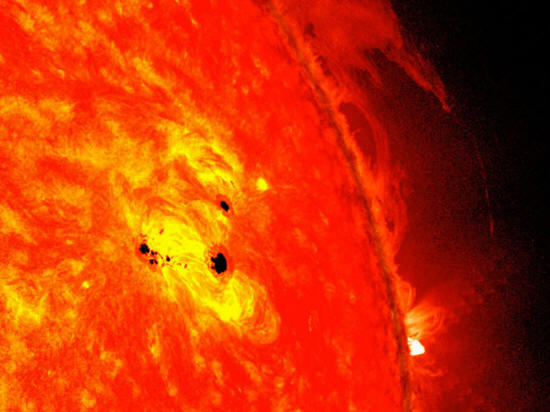|
known as sunspots, appeared quickly in February 2013, and each is
as wide
across as six Earths.
Goddard
Space Flight Center
But, will the resulting
cooling put a dent in the "global
warming" trend?
...all bringing a
cooler period to the planet that
may span 50 years.
Known as the
Maunder Minimum, it occurred
between 1645 and 1715, during a longer span of time when parts of
the world became so cold that the period was called the
Little Ice Age, which lasted
from about 1300 to 1850.
Though a new decades-long
dip in solar radiation could slow global warming somewhat, it
wouldn't be by much, the researchers' simulations demonstrated. And
by the end of the incoming cooling period, temperatures would
have bounced back from the temporary cool-down.
This episode corresponded
with a period of exceptional cold in parts of the world,
which scientists have explained as being connected to the changes in
solar activity.
But a pattern of ever-decreasing sunspots over recent solar cycles resembles patterns from the past that preceded grand-minimum events.
This similarity hints that another such event may be fast approaching, the researchers reported in the study. And the scientists have estimated how intense such an event might be, by analyzing close to 20 years of data recording radiation output from stars that follow cycles similar to that of our sun.
Solar radiation output typically drops during a normal solar minimum, though not enough to disrupt climate patterns on Earth.
However, UV radiation output during a grand minimum could mean activity plummets by an additional 7 percent, the researchers wrote in the study (Ultraviolet Flux Decrease Under a Grand Minimum from IUE Short-wavelength Observation of Solar Analogs).
As a result, air
temperatures on Earth's surface would cool by as much as several
tenths of a degree Fahrenheit (a change of a half-degree F is the
equivalent to about three-tenths of a degree Celsius) on average,
according to the study.
...the study's lead author, Dan Lubin, a research physicist with the Scripps Institution of Oceanography at the University of California, San Diego, said in a statement:
The findings (Ultraviolet
Flux Decrease Under a Grand Minimum from IUE Short-wavelength
Observation of Solar Analogs) were published online Dec.
27, 2017, in The Astrophysical Journal Letters.
|


